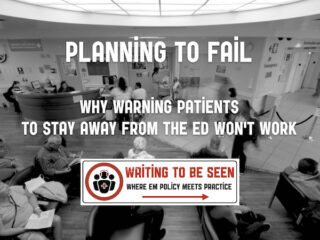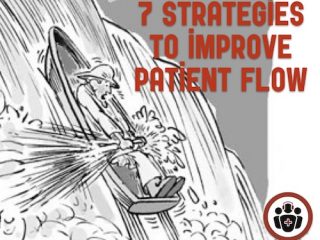
Waiting to Be Seen: Where EM Policy Meets Practice is an EM Cases blog series, authored by Dr. Howard Ovens, a veteran Emergency Department Director, whose main purpose is to share ideas and generate discussion on the role that public policy and administrative practices play in creating the conditions that help front line emergency providers achieve better patient outcomes. You can contact Dr. Ovens at howard.ovens@utoronto.ca and follow him on Twitter at @HowardOvens.
WTBS 18 Zero-Tolerance Policies in the ED Part 2: Taking a Look in the Mirror
Are there things we can do in the ED to reduce the risk of violence? We focus on some of the high-risk populations that are often involved in situations that escalate and suffer the consequences of ED responses. Let's move beyond non-violent de-escalation, examine our underlying attitudes, and explore strategies to prevent escalation on this Waiting to Be Seen blog...
WTBS 17 Zero-Tolerance Policies in the ED, Part 1: The delicate balance of protecting staff while ensuring patient access
We often face violence in the ED. Yet the ED is a sanctuary for care and support. Many EDs have a zero-tolerance policy for violence. In this Waiting to Be Seen blog Dr. Howard Ovens examines the issues we face in Emergency Departments as we try to make staff feel safe and ensure patients can access the care they need. He reframes violence in the ED as a public health issue and offers strategies for a safe ED...
WTBS 16 Listening for the QI Signal in the Noise of ED Return Visits: Focus on Missed MI
Jesse McLaren outlines 10 Quality Improvement (QI) opportunities for reducing missed AMIs and the lessons learned from Ontario’s Emergency Department Return Visit Quality Program in this Waiting to Be Seen blog...
WTBS 15 Planning to Fail: Why Warning Patients to Stay Away from the ED Will Never Work
It’s been another trying flu season in the northern hemisphere—for patients and for emergency department (ED) providers. EDs that are crowded at the best of times come close to a tipping point, waits to be seen and for beds climb, and hospitals struggle to handle the load, sometimes coping by putting patients in hallways or lounges. Even well-written surge plans fall apart in the face of staff illness or unit outbreaks. Too often when trying to help the system cope, a hospital, health region, or government puts out a call for the public to stay away from crowded EDs unless absolutely necessary—but are such warnings ethical or effective?
WTBS 14 Improving Patient Flow in the ED: 7 Strategies for Nurses
It is both an evidence-based truth and almost a mantra of emergency department (ED) providers and leaders that the major cause of ED overcrowding is boarded patients. Yet 10 years of experience in more than 70 EDs has shown that impressive flow gains can be achieved despite a poor flow of admitted patients out of the ED. While I have always been and continue to be an advocate for improved admission processes and better ED resources, these issues should never excuse us from exploring our own role in improving flow in our departments. Fostering a culture in which all staff are committed to improving care through better flow will trump petty concerns about hierarchies and role descriptions—and it will improve morale.
WTBS 13 Transgender Patients: How to Foster a Safer Emergency Department Environment
In this EM cases Waiting to Be Seen blog we discuss how to make Emergency Departments safe places for transgender patients to access care that is informed and non-judgmental. A big part of our job is to advocate for our patients. Dr. Nadia Primiani helps us understand where some of our most vulnerable populations are coming from and aims to improve our familiarity and comfort with issues around gender to improve care...







